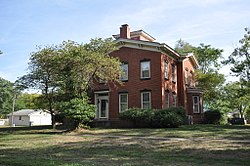
The East Grove Street District is a residential historic district located on the 400 through 700 blocks of East Grove Street in Bloomington, Illinois. The district includes 43 houses and apartment buildings, 25 of which are considered contributing buildings. The houses in the district were built between 1855 and 1915 for many of Bloomington's upper middle class residents. Due to a building boom between 1880 and 1900, the then-popular Queen Anne style is the most prevalent in the district. Other popular architectural styles in the district include Greek Revival homes from the 1850s, Italianate homes built between 1860 and 1880, and Arts and Crafts homes built in the 1900s.

The William H. Roberts House is a late 19th-century house located in Pecatonica, Illinois, United States. The house was built in 1883 for Dr. William H. Roberts, who died three years later at the age of 33. The building features a combination of elements from three distinct architectural styles, Italianate, Queen Anne and Gothic revival. The building functioned as both Roberts's house and office. The house is the only building in Pecatonica listed on the United States National Register of Historic Places, a status it attained in 1979.

The Chick House is a former hotel building constructed in 1857 in the city of Rockford, Illinois, United States. The building's construction was financed by three Rockford citizens and it operated as a hotel from its opening until 1951. The hotel was purchased by Thomas Chick in 1888 and he renamed it from the Griggs House to the Chick House. In 2004 the city of Rockford purchased two-thirds of the building and made some modifications to the structure. The building is a mesh between the Greek Revival and Italianate styles and feature simple ornamentation that contrasts with a neighboring building. The Chick House is a Rockford Landmark and was listed on the U.S. National Register of Historic Places in 1997.
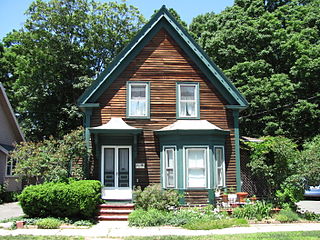
322 Haven Street in Reading, Massachusetts is well preserved cottage with Gothic and Italianate features. Built sometime before 1889, its use of even modest Gothic features is unusual in Reading, where the Gothic Revival was not particularly popular. The house was listed on the National Register of Historic Places in 1984.
The Cherryfield Historic District encompasses the historic village center of Cherryfield, Maine. This area is distinctive for its collection of high-quality 19th century architecture, which is unique in rural contexts in the state. The district was listed on the National Register of Historic Places in 1990.

The Saco Historic District encompasses the historic commercial and residential centers of Saco, Maine. Covering more than 100 acres (40 ha) of central Saco, it includes houses from the 18th through 20th centuries, and the main business district along Main Street. It was added to the National Register of Historic Places in 1998.
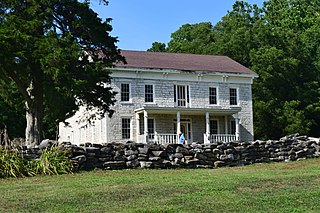
The James John Eldred House is a historic house located in Bluffdale Township near Eldred, Illinois. The house was built in 1861 by James J. Eldred, who lived in the home with his family until 1901. The house was designed in the Greek Revival style and also includes features of the Italianate style. The front of the house has five symmetrical bays and a front porch. The main entry, located in the porch, is bordered by sidelights and a transom. The house's cornice features Greek Revival dentils and pediments and Italianate bracketing. Palladian windows are located on the house's east and west sides. Many of the interior details of the house are original, including its fireplace mantels and much of its woodwork.

The Prospect Street Historic District encompasses approximately 5.5 acres northwest of the central business district of New London, Connecticut. The district is bounded by Bulkeley Place on the north, Hempstead Street on the west, Federal Street on the south and Huntington Street on the east. Prospect Street bisects the district on a north-south axis. The residential area includes 24 buildings, most of which are Greek Revival or Italianate houses built between 1838 and 1859. The area was developed in response to local demand for increased middle-class housing, and the dense development and modest scale of the buildings is reflective of this objective.

The Joliet East Side Historic District is a set of 290 buildings in Joliet, Illinois. Of these 290 buildings, 281 contribute to the historical integrity of the area. Joliet was founded in 1831, deemed an ideal place for a settlement to reap the local natural resources. Most importantly, large beds of limestone provided a strong economic incentive to develop the area. Several important structures were constructed with Joliet limestone, including the Old State Capitol and Chicago Water Tower. Joliet incorporated in 1852 and prospered due to its location on the Illinois and Michigan Canal.

The Central Geneva Historic District is a set of 102 buildings and structures in Geneva, Illinois. Of those, 68 contribute to the district's historical integrity. The district is representative of southern Geneva, south of Illinois Route 38. Among the noted buildings is the Kane County Courthouse and the Frank Lloyd Wright-designed P. D. Hoyt House. The district was added to the National Register of Historic Places in 1979, and was enlarged in 2017.

St. Mary Historic District is a national historic district located at Lafayette, Tippecanoe County, Indiana. In 1864, St. Mary's Catholic Church relocated from its original site at Fifth and Brown Streets to Columbia Street. With the move, many of the congregation also moved to this area. The Church became both a religious and social center for the neighborhood. Many of the homes date from the 1860s and 1870s and include fine examples of the Italianate, Greek Revival and Queen Anne styles as well as vernacular house types. Most of the people who built in this area were Lafayette businessmen. At 1202 Columbia Street James Ball, a local wholesale grocer left his name stamped into the front steps. Across the street is the James H. Ward House, who along with his brother, William, owned a local carpet and wallpaper business.
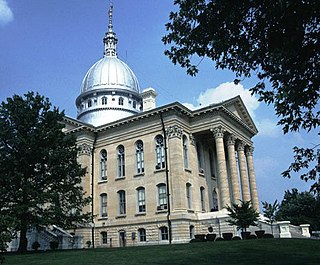
The Carlinville Historic District includes the oldest sections of Carlinville, Illinois. The district consists of much of central and eastern Carlinville and is roughly bounded by Oak Street, Mulberry Street, Morgan Street, and the eastern city limits. The Macoupin County Courthouse, a Beaux-Arts building built in 1867–70, is the focal point of the district. The courthouse is situated in a public square in downtown Carlinville and is surrounded by some of the city's oldest businesses. The district also includes large residential sections; popular architectural styles in these areas include Federal, Greek Revival, Italianate, and Queen Anne.

Edwards Place is a historic house located at 700 North 4th Street in Springfield, Illinois. The house was begun in 1833 in the Greek Revival style, making it one of the oldest houses in Springfield. Additions in 1836 and 1843, and a major rebuild/expansion in 1857, created the Italianate house preserved today. The house's Italianate features include bracketed cornices and a cupola with a skylight.

The Rippon-Kinsella House is a historic house located at 1317 North Third Street in Springfield, Illinois. The house was most likely built in 1871 for businessman John Rippon, Jr. Its original design was a simple Italianate plan; the style can still be seen in its bracketed eaves and its long arched windows with round hoods. Rippon sold the house in 1891, and after passing through several other owners it was bought by Richard "Dick" Kinsella in 1899. Kinsella ran a local wallpaper and paint business, worked as a scout for the New York Giants baseball team, and was a prominent Sangamon County Democrat. In 1905, Kinsella remodeled his house to incorporate Classical elements; the house's porch with Doric columns and its high-pitched roof were added at this time. Classical Revival architecture was popular in both new and remodeled houses in Springfield at the time, and the more traditional Italianate houses were well-suited to renovations; the house is one of the best-preserved examples of these hybrid designs.

The Lucinda Hunter House is a historic house located at 101 East 8th Street in Vermont, Illinois, United States. The house was built in the early 1870s for Lucinda Hunter, the mother of village postmaster John Hiram Hunter. The house is an example of the Gable Front type of the Side Hall plan, a vernacular style popular for much of the 19th century. The Side Hall plan as exhibited in the house features two rooms on each story connected by a hall to the side; the Gable Front type reflects its roof form, a gable roof with a front-facing gable. Elements of several popular architectural styles decorate the house, such as the Greek Revival entrance, Italianate arched windows, and Gothic pointed arches on the porch.

The Joab Mershon House is a historic house located at 507 West 5th Street in Vermont, Illinois. Joab Mershon, a local pork packer and banker, had the house built for his family in 1859. The house has an Italianate design with Greek Revival elements; at the time of its construction, the former style was emerging in popularity while the latter was declining, and the house represents a transitional work between the two styles. The Italianate influence is seen most prominently in the hip roof, which features a bracketed cornice and a cupola with matching brackets. Key Greek Revival elements include the dentillation on the entrance and cupola and the ornamental cast iron lintels. The house's interior has a four-over-four plan, which features four rooms on each floor and a central hallway.
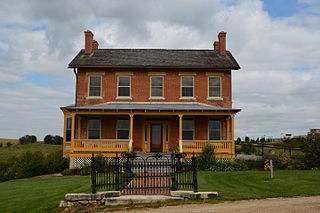
The Henry W. Miller House is a historic house located at 11672 West Norris Lane in Galena, Illinois. Henry W. Miller, a flour wholesaler and dealer who played an important role in Galena's large flour-producing industry, had the house built between 1847 and 1850. The house was built on a plot of land overlooking the plank toll road that connected Galena to Dubuque, Iowa and Mineral Point, Wisconsin; the route, which is now part of U.S. Route 20, eventually became known for its collection of large, elaborate homes. Miller chose the popular Greek Revival style for his house; its design features sidelights and a transom around the front door, a door surround with pilasters and dentillation, and a symmetrical front with six-over-six windows. Richard Barrett, who owned the house in the 1870s, added its Italianate bay window.

The Augustus and Laura Blaisdell House is a historic house at 517 Depot Street in Chester, Vermont. Built in 1868 for a local businessman, it is a fine local example of transitional Greek Revival-Italianate architecture. It has historically served both commercial and residential functions, and now contains apartments. It was listed on the National Register of Historic Places in 2014.
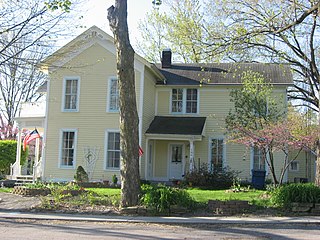
Eli Sigler House, also known as the John Sigler House, is a historic home located at Hebron, Porter County, Indiana. It was built about 1867, and is a two-story, vernacular frame dwelling with Greek Revival and Italianate style design elements. It has a gabled ell plan and a large two-story addition constructed about 1935.
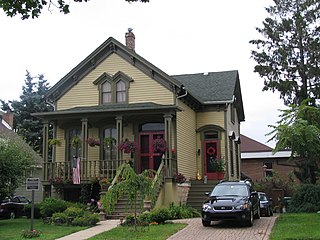
The Joshua P. Young House, also known as the McGee House, is a historic house at 2445 High Street in Blue Island, Illinois. The house was built in 1852 for land developer Joshua P. Young, who led the development of both Blue Island and many neighborhoods on Chicago's South Side. Young also helped bring the Rock Island Railroad through Blue Island and led the city's Board of Trustees for two years. The house has a Chicago Cottage plan, a style of balloon framing popular in mid-nineteenth century Chicago; as the style was banned in Chicago after the Great Chicago Fire burned through many of the homes, surviving examples are relatively uncommon. The house's detailing is eclectic, incorporating elements of Greek Revival, Italianate, and Gothic architecture.
